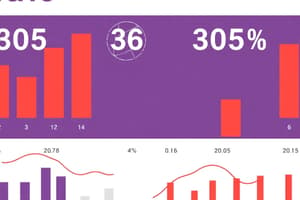Podcast
Questions and Answers
Which statement accurately describes a limitation of descriptive research?
Which statement accurately describes a limitation of descriptive research?
- It can only identify relationships that are statistically meaningful.
- It does not allow for the determination of cause-and-effect relationships. (correct)
- It allows for causal inference between variables.
- It requires complex statistical analysis.
In what way do cohort studies differ from case control studies in terms of evaluating relationships?
In what way do cohort studies differ from case control studies in terms of evaluating relationships?
- Outcome data in case control studies is more reliable than in cohort studies.
- Case control studies can evaluate causal relationships effectively.
- Cohort studies can more reliably establish a causal relationship if properly conducted. (correct)
- Cohort studies only analyze outcomes after identifying exposures.
Which option correctly identifies an extraneous variable concern in case series studies?
Which option correctly identifies an extraneous variable concern in case series studies?
- Participants are often randomly assigned to conditions.
- All data collection methods are standardized.
- Statistical analyses are rigorously applied to all findings.
- There is a high potential for selection and measurement bias. (correct)
What distinguishes descriptive statistics from inferential statistics in research design?
What distinguishes descriptive statistics from inferential statistics in research design?
What is a primary weakness of case reports as a study design?
What is a primary weakness of case reports as a study design?
What is the primary purpose of matching cases and controls in a case-control study?
What is the primary purpose of matching cases and controls in a case-control study?
What statistical measure is primarily used to report the effect of exposure on outcome in a case-control study?
What statistical measure is primarily used to report the effect of exposure on outcome in a case-control study?
Which of the following is a significant weakness of a cohort study?
Which of the following is a significant weakness of a cohort study?
What type of bias arises from the procedures used to select subjects in a study?
What type of bias arises from the procedures used to select subjects in a study?
In case-control studies, what is a common challenge researchers encounter?
In case-control studies, what is a common challenge researchers encounter?
Flashcards are hidden until you start studying
Study Notes
Descriptive and Inferential Statistics
- Descriptive statistics are employed exclusively for descriptive research.
- Inferential statistics are not applicable in descriptive research contexts.
Case Reports and Case Series Design
-
Case Reports
- Identify rare occurrences and delayed adverse drug reactions (ADRs).
- Generate hypotheses with minimal resource requirements.
- Lack statistical analysis and risk potential reporting bias.
-
Case Series
- Study outcomes closer to routine clinical practice and can be cost-effective.
- Useful when randomized controlled trials are unfeasible.
- Vulnerable to selection and measurement biases, and absolute risk cannot be calculated.
Observational Studies
- Main types include cohort studies and case-control studies.
- Both types can evaluate causal relationships when executed properly, challenging notions that case-control studies cannot.
- These designs are influenced by various biases and do not incorporate randomization.
Case-Control Study
-
Involves matching cases with controls from the same population.
-
Control sources may include neighborhood members, hospital patients, friends, or family (e.g., twins).
-
Matching ensures differences between groups are limited to the exposure variable, accounting for confounding factors.
-
Outcomes are typically expressed using Odds Ratio.
-
Strengths
- Efficient for studying rare outcomes or long exposure intervals.
- Cost-effective and quick to conduct.
-
Weaknesses
- Pronounced susceptibility to diverse biases.
- Difficult to control for all confounding variables except exposure.
- Ambiguity regarding the timing of exposure relative to outcomes.
Cohort Study
-
Participants selected based on exposure status, not outcome, starting without the outcome of interest.
-
Can be prospective or retrospective in design.
-
Notable examples: Framingham Study and Swiss HIV Study.
-
Outcomes reported as Relative Risk.
-
Strengths
- Useful for researching harmful exposures and establishing incidence rates of outcomes.
- Allows retrospective or prospective examination of exposure effects.
-
Weaknesses
- Prone to confounding factors and expensive with larger patient recruitment than case-control studies.
- Less efficient for long exposure-outcome intervals.
Selection Bias
- Arises from selection procedures and factors influencing study participation.
- Mitigated by matching subjects on known factors (e.g., age, gender) or random assignment to experimental conditions.
Control Group
- Essential for managing extraneous variables.
- Control groups should resemble experimental groups, differing only regarding treatment involvement.
- Ensures consistency in attention and procedural treatment across both groups.
Types of Studies
- Descriptive
- Focus on novel clinical signs, symptoms, or events.
- Observational
- Examine participants based on specific characteristics or outcomes.
- Experimental
- Include random assignment of participants to different conditions.
Descriptive Study Subtypes
- Case Study
- Details an individual with a novel or unusual condition.
- Case Series
- Summarizes multiple individuals with a similar novel clinical finding.
- Aims to inform the healthcare community about unusual clinical events or adverse reactions.
Limitations of Descriptive Studies
- Do not provide inferential evidence regarding cause-effect relationships.
- Lack control groups and do not manage confounding or extraneous variables.
Studying That Suits You
Use AI to generate personalized quizzes and flashcards to suit your learning preferences.




